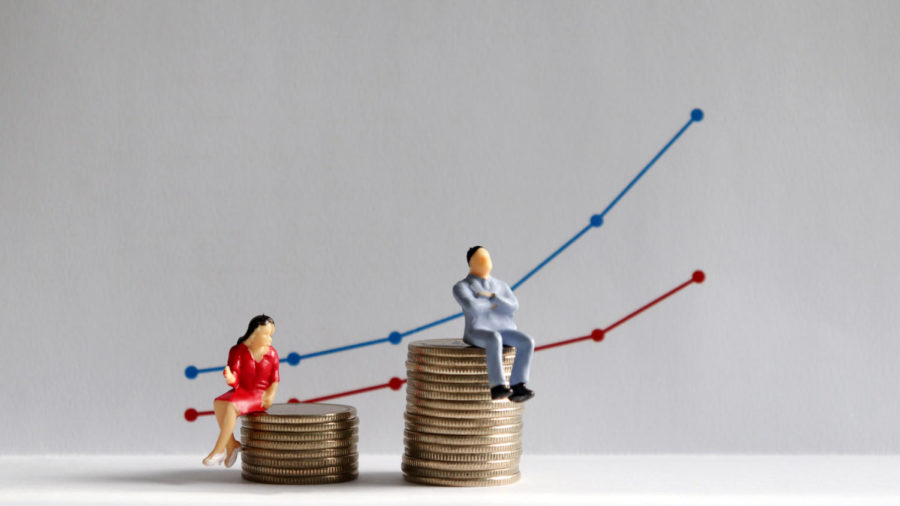Fox: Assessing the gender wage gap
The concept of gender pay gap. A miniature man and a miniature woman sitting on top of a pile of coins at different heights in front of a bar graph.
April 28, 2019
It’s a modern world. Things are a lot more equal than they used to be in terms of gender and sex equality. Women can wear pants, and men hopefully no longer subscribe to the idea that women can’t ride trains because “women’s bodies are not made to go over 50 miles an hour,” and therefore their uteruses will fall out. Women can go to college, and men most likely no longer believe that women shouldn’t ride bicycles because it will give them a permanent nasty scowl and depression. Women can vote and no longer have to go to their doctor to cure themselves of sexual frustration caused by the ineptitude of their partners. And yet, there are still prominent issues for women’s equality that sound just as outrageous as these previous male suggestions: women, on average, are paid less than their male counterparts. Although it may be hard to believe, the wage gap is quite real and it’s frightening.
Of course, a claim such of this should be explored in detail. Many people believe that women make only $0.78 to the man’s $1.00. This estimate is even smaller for women of color. While this is true as an average across all occupations, it is important to explore what this really means. For example, women in retail on average make 70 percent of what men in retail make, whereas female lawyers on average make 83 percent of what men make.
Women aren’t complacent with these numbers, either. Many women try to balance the scale and ask for higher pay. Unfortunately, women who negotiate for raises succeed only 24 percent of the time, whereas men succeed 42 percent of the time. This is scary, especially considering women ask for raises more often than men.
This sort of bias isn’t the only reason that women make less than men. In the United States, the population of women and men is nearly 50-50, and women are, on average, earning more bachelor’s degrees than men. However, only 6.7 percent of women are graduating from college in STEM fields, mostly in psychological and biological sciences.
In 2016, the ratio of women to men obtaining degrees in the STEM field was 37 to 63 percent. How does this influence the wage gap? The Bureau of Labor Statistics cites that 93 out of 100 STEM careers offer wages above the national average, and the field is only growing.
The fastest-growing, highest-paying STEM jobs are typically engineering and computer science. In other words, many women are graduating from college and getting degrees in areas other than STEM. Not only that, but when women do choose STEM majors, they don’t choose the highest paying careers. This is, in my opinion, mostly because of something that sounds like a tasty treat but is actually a dreaded social construct: gender roles.
Even in 2019, women are thought of in a certain way, or has having certain roles, such as cooking, cleaning, taking care of children and so on. Any female alive today can likely cite a time when they were made uncomfortable by being told that they shouldn’t behave a certain way because of their sex or gender. Even when people don’t consciously believe these stereotypes about women, it can still unconsciously modify their behavior. In other words, the mere existence of these stereotypes, regardless of whether or not anyone believes them, can greatly affect what women choose to do. In turn, these subconscious stereotypes may even affect one’s decision on a women’s hiring, pay rate and more. In fact, women with overtly feminine names were offered on average $4000 less than their less-feminine counterparts in one study.
Even if women can ride trains and keep their uteri intact, it is seemingly impossible for women to obtain pay equal to that of a man’s. The first step in the right direction to wage equality is to erase gender roles and stereotypes entirely to ensure there is no bias for hiring and firing.







